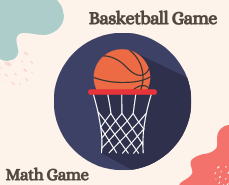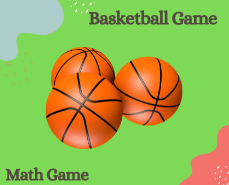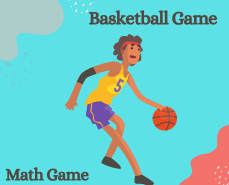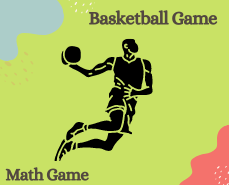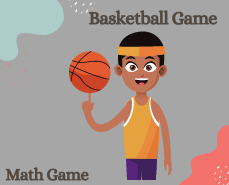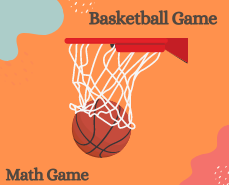Math Games with Basketball | Basketball Games for Math
Basketball is a popular sport that captivates the hearts of many. It combines physical activity, teamwork, and strategy. But did you know that basketball can also be a great way to learn and practice math skills? Math games with basketball not only make learning math enjoyable but also provide a hands-on approach to reinforce mathematical concepts. In this article, we will explore the benefits of incorporating math games with basketball into education and share some exciting game ideas to make math learning a slam dunk!
Introduction
Mathematics is a subject that many students find challenging and sometimes overwhelming. However, incorporating interactive and engaging activities can transform the learning experience. Math games with basketball offer a dynamic approach to teaching and learning, enabling students to apply math concepts in a real-world context. These games not only enhance mathematical skills but also foster teamwork, critical thinking, and problem-solving abilities.
Benefits of Math Games with Basketball
Math games with basketball offer numerous benefits for students. Here are some of the advantages of integrating these games into the learning process:
-
Engaging Learning Experience: By combining math with basketball, students become actively involved in the learning process. The hands-on nature of these games makes math more enjoyable and helps students retain information better.
-
Real-World Application: Math games with basketball provide a practical application of mathematical concepts. Students can see how math is used in a sport they love, making the subject more relatable and relevant to their lives.
-
Teamwork and Collaboration: Many math games with basketball require teamwork and collaboration. Students work together to solve problems, strategize, and compete. This fosters valuable interpersonal skills and promotes a sense of camaraderie among students.
-
Critical Thinking and Problem-Solving Skills: Math games with basketball involve analyzing situations, making decisions, and finding solutions. These games challenge students to think critically, develop problem-solving skills, and apply mathematical concepts in different scenarios.
-
Increased Motivation: Incorporating games into the learning process increases students' motivation and enthusiasm for math. The element of competition and the interactive nature of these games make math learning more exciting and enjoyable.
Addition and Subtraction Slam
One of the fundamental mathematical operations is addition and subtraction. The Addition and Subtraction Slam game combines these operations with basketball for an engaging learning experience. Here's how to play:
-
Objective: To solve addition and subtraction problems correctly and score points by shooting the ball into the hoop.
-
Materials: A basketball, a hoop or basket, and flashcards with addition and subtraction problems.
-
Instructions:
a. Place the flashcards face down near the hoop.
b. The player picks a flashcard, reads the problem aloud, and solves it mentally.
c. If the answer is correct, the player shoots the ball into the hoop. Each successful shot earns a certain number of points.
d. Continue playing and keep track of the points earned.
e. The player with the highest score wins.
This game not only improves addition and subtraction skills but also enhances hand-eye coordination and focus.
Multiplication Madness
Multiplication is another essential mathematical operation. The Multiplication Madness game helps students practice their multiplication skills while enjoying the thrill of basketball. Here's how to play:
-
Objective: To correctly solve multiplication problems and score points by shooting the ball into the hoop.
-
Materials: A basketball, a hoop or basket, and flashcards with multiplication problems.
-
Instructions:
a. Scatter the flashcards face down around the hoop.
b. The player chooses a flashcard, reads the multiplication problem aloud, and provides the correct answer.
c. If the answer is correct, the player shoots the ball into the hoop. Each successful shot earns a specific number of points.
d. Keep track of the points earned and continue playing.
e. The player with the highest score wins.
Multiplication Madness not only reinforces multiplication skills but also improves accuracy and quick thinking.
Division Dribble
Division is a mathematical operation that challenges students' problem-solving abilities. The Division Dribble game combines division with basketball to make learning more interactive. Here's how to play:
-
Objective: To correctly solve division problems and score points by dribbling the ball through a series of cones or markers.
-
Materials: A basketball, cones or markers, and flashcards with division problems.
-
Instructions:
a. Set up a course using cones or markers.
b. Place the flashcards face down near the starting point.
c. The player picks a flashcard, reads the division problem aloud, and solves it mentally.
d. After solving the problem, the player dribbles the ball through the course, following a specific path or avoiding certain markers.
e. Continue playing, keeping track of the points earned.
f. The player with the highest score wins.
Division Dribble enhances division skills, improves coordination, and adds a physical element to math learning.
Geometry Shootout
Geometry plays a crucial role in understanding shapes, spatial relationships, and measurements. The Geometry Shootout game incorporates geometry concepts into basketball for an engaging learning experience. Here's how to play:
-
Objective: To correctly identify geometric shapes and score points by shooting the ball into hoops designated for specific shapes.
-
Materials: A basketball, hoops or baskets, and cards or posters displaying different geometric shapes.
-
Instructions:
a. Set up hoops or baskets in different areas, each labeled with a specific geometric shape.
b. Show the player a card or poster displaying a shape.
c. The player identifies the corresponding shape and shoots the ball into the hoop designated for that shape.
d. Each successful shot earns a certain number of points.
e. Continue playing and keep track of the points earned.
f. The player with the highest score wins.
Geometry Shootout not only reinforces geometry concepts but also improves spatial recognition and accuracy.
Fractions Free Throw
Fractions are an important part of mathematics, and the Fractions Free Throw game provides an exciting way to practice fraction skills. Here's how to play:
-
Objective: To correctly identify fractions and score points by shooting the ball into hoops labeled with the corresponding fraction.
-
Materials: A basketball, hoops or baskets, and cards or posters displaying different fractions.
-
Instructions:
a. Set up hoops or baskets labeled with different fractions.
b. Show the player a card or poster displaying a fraction.
c. The player identifies the corresponding fraction and shoots the ball into the hoop labeled with that fraction.
d. Each successful shot earns a certain number of points.
e. Continue playing and keep track of the points earned.
f. The player with the highest score wins.
Fractions Free Throw not only reinforces fraction skills but also improves accuracy and visual recognition of fractions.
Measurement Bounce
Measurement is a vital aspect of mathematics, and the Measurement Bounce game helps students practice measuring skills while enjoying the game of basketball. Here's how to play:
-
Objective: To correctly measure distances and score points by bouncing the ball from designated spots.
-
Materials: A basketball, measuring tape, and markers or cones.
-
Instructions:
a. Set up markers or cones at various distances from the starting point.
b. The player selects a marker and uses the measuring tape to determine the distance.
c. The player then bounces the ball from the starting point, aiming to land it as close as possible to the designated marker.
d. The player scores points based on the accuracy of the bounce.
e. Continue playing and keep track of the points earned.
f. The player with the highest score wins.
Measurement Bounce enhances measuring skills, promotes estimation abilities, and adds a fun element to math learning.
Algebra Alley-Oop
Algebra can be a challenging topic for students, but the Algebra Alley-Oop game makes it more approachable and enjoyable. Here's how to play:
-
Objective: To solve algebraic equations correctly and score points by shooting the ball into the hoop.
-
Materials: A basketball, a hoop or basket, and flashcards with algebraic equations.
-
Instructions:
a. Scatter the flashcards face down near the hoop.
b. The player selects a flashcard, reads the algebraic equation aloud, and solves for the variable.
c. After solving the equation, the player shoots the ball into the hoop. Each successful shot earns a specific number of points.
d. Keep track of the points earned and continue playing.
e. The player with the highest score wins.
Algebra Alley-Oop reinforces algebraic concepts, improves problem-solving skills, and adds an element of excitement to learning.
Probability Dunk
Probability is a mathematical concept that is often misunderstood. The Probability Dunk game helps students grasp probability concepts by relating them to basketball. Here's how to play:
-
Objective: To correctly determine the probability of an event and score points by shooting the ball into the hoop.
-
Materials: A basketball, a hoop or basket, and cards or posters displaying different events.
-
Instructions:
a. Show the player a card or poster displaying an event.
b. The player estimates the probability of that event occurring and shoots the ball into the hoop accordingly.
c. Each successful shot earns a certain number of points based on the estimated probability.
d. Continue playing and keep track of the points earned.
e. The player with the highest score wins.
Probability Dunk enhances understanding of probability concepts and improves estimation skills.
Data Analysis Hoops
Data analysis is an essential skill in today's data-driven world. The Data Analysis Hoops game combines data analysis with basketball for a unique learning experience. Here's how to play:
-
Objective: To analyze data and answer questions correctly to score points by shooting the ball into the hoop.
-
Materials: A basketball, a hoop or basket, and data sets with corresponding questions.
-
Instructions:
a. Show the player a data set along with a series of questions.
b. The player analyzes the data and answers the questions.
c. Each correct answer earns the player a certain number of points when shooting the ball into the hoop.
d. Keep track of the points earned and continue playing.
e. The player with the highest score wins.
Data Analysis Hoops enhances data analysis skills, critical thinking, and decision-making abilities.
Problem-Solving Challenge
Problem-solving is a crucial skill in mathematics and various other areas of life. The Problem-Solving Challenge game encourages students to apply their problem-solving abilities while playing basketball. Here's how to play:
-
Objective: To solve mathematical problems and score points by successfully completing basketball-related challenges.
-
Materials: A basketball, a hoop or basket, and a set of problem-solving tasks.
-
Instructions:
a. Assign problem-solving tasks related to basketball, such as calculating scores, determining statistics, or analyzing game scenarios.
b. The player solves each task and completes the corresponding basketball challenge successfully.
c. Each completed challenge earns the player a certain number of points.
d. Keep track of the points earned and continue playing.
e. The player with the highest score wins.
The Problem-Solving Challenge game enhances problem-solving skills, critical thinking, and mathematical reasoning.
Math Games with Basketball in the Classroom
Math games with basketball can be incorporated into the classroom to create an engaging and interactive learning environment. Teachers can introduce these games during math lessons, math clubs, or as part of physical education activities. By combining math concepts with the excitement of basketball, students will develop a deeper understanding of mathematical principles while enjoying the learning process.
Math Games with Basketball at Home
Parents and guardians can also incorporate math games with basketball into their children's home learning routine. These games provide an opportunity for family engagement and make math learning a fun and interactive experience. By playing math games with basketball at home, children can strengthen their math skills while enjoying quality time with their loved ones.
Conclusion
Math games with basketball offer a unique and exciting way to learn and reinforce mathematical concepts. By integrating these games into education, students can experience a hands-on approach to math, making the subject more enjoyable and relatable. The benefits of math games with basketball go beyond mathematical skills, fostering teamwork, critical thinking, problem-solving abilities, and a love for learning. So grab a basketball, gather your friends or family, and embark on a journey of math learning and basketball fun!
FAQs
1. Can math games with basketball be used for students of all ages?
Yes, math games with basketball can be adapted for different age groups. The complexity of the games and the level of difficulty can be adjusted according to the students' grade level and mathematical proficiency.
2. Do I need a basketball court to play these games?
Not necessarily. Many of the math games with basketball can be played in a classroom, gymnasium, or even outdoors in a designated area with a hoop or basket.
3. Are these math games only suitable for students who are interested in basketball?
No, these math games are designed to engage and benefit all students, regardless of their interest in basketball. The focus is on integrating math concepts with a popular sport to make learning more enjoyable and relatable.
4. How can teachers assess student progress when using math games with basketball?
Teachers can assess student progress by observing their problem-solving skills, accuracy, and ability to apply mathematical concepts during the games. They can also evaluate students' understanding through follow-up discussions and related assignments or assessments.
5. Where can I find additional math games with basketball ideas and resources?
There are various educational websites, books, and online platforms dedicated to providing math games and resources. Additionally, teachers and educators can collaborate and share ideas within their

